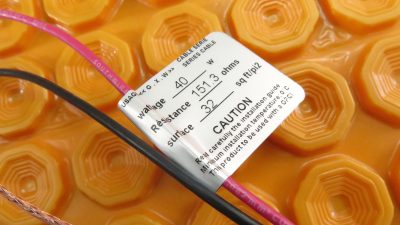 UPDATED 20Dec2019 + video: The phrase “cold feet” is more than just something someone says when they’ve lost enthusiasm. In some houses it’s a permanent source of literal discomfort each winter. Bathrooms, basements, floors over crawlspaces and those notoriously cold bedrooms over garages are all likely sources of suffering, and electric infloor heating is part of a solution you should know about.
UPDATED 20Dec2019 + video: The phrase “cold feet” is more than just something someone says when they’ve lost enthusiasm. In some houses it’s a permanent source of literal discomfort each winter. Bathrooms, basements, floors over crawlspaces and those notoriously cold bedrooms over garages are all likely sources of suffering, and electric infloor heating is part of a solution you should know about.
Mat-style infloor electric heating systems have been available for years. Trouble is, I have not been impressed. Some systems I’ve worked with aren’t customizable for each job, nor are they particularly reliable. And when electric infloor heating stops working, that’s a big headache because all the flooring probably needs to come up to repair the bad mats. There is a better way.
 DITRA-HEAT is the easiest to install and best-warranted cable-style electric infloor system I’ve worked with. It’s my favourite by far. Unlike other systems, I’ve never had DITRA-HEAT let me down. The system includes a dimpled plastic underlay that’s made for heating cables to snap in only where needed. Anchor the special DITRA underlay to the floor with thinset mortar, pop the cable in place from a spool around cabinets, appliances and other areas that need no heat, then cap the whole thing off with more thinset and tiles. Time-of-day thermostat allows you to pay only for the heat they need, and independent control of floor temperature lets you dial in just the right amount of floor heat relative to room temperature. Electric infloor heating systems aren’t usually powerful enough to heat spaces entirely on their own, but they’ll make your feet a whole lot happier.
DITRA-HEAT is the easiest to install and best-warranted cable-style electric infloor system I’ve worked with. It’s my favourite by far. Unlike other systems, I’ve never had DITRA-HEAT let me down. The system includes a dimpled plastic underlay that’s made for heating cables to snap in only where needed. Anchor the special DITRA underlay to the floor with thinset mortar, pop the cable in place from a spool around cabinets, appliances and other areas that need no heat, then cap the whole thing off with more thinset and tiles. Time-of-day thermostat allows you to pay only for the heat they need, and independent control of floor temperature lets you dial in just the right amount of floor heat relative to room temperature. Electric infloor heating systems aren’t usually powerful enough to heat spaces entirely on their own, but they’ll make your feet a whole lot happier.
Installed in strategic places wherever it matters most in bedrooms, bathrooms or even just in front of the couch, electric infloor heating systems offer a lot more flexibility for retrofitting spaces at economical prices. If you’re ever trying to warm up one of those cold, over-the-garage bedrooms, you’ll need to do more than just put wires in the floor. Two inch-thick extruded polystyrene foam sheets make great floor insulation. Cover the existing subfloor with this foam, then fasten a 5/8” plywood subfloor on top, secured with screws driven down into the existing floor and joists. There’s no need for strapping. The foam is dense enough to support the new plywood subfloor. Install electric infloor heating and new flooring and you’ll be a lot warmer.
Is the ceiling of the garage under the bedroom open and uncovered by drywall? Spray foam insulation applied to the underside of the floor between joists will warm the bedroom a lot if you’d rather not insulate from above. It takes a total of 3” depth of closed cell foam to function as a vapour barrier in places where winter temperatures drop well below freezing.
Why not just use hot water radiant infloor heating instead of electric? Hot water heating is an amazing technology, and electric infloor systems aren’t good substitutes for it in larger spaces because they don’t have the heating power. That said, electric systems are more nimble and easier to install as a luxurious supplemental heat source in certain areas, especially when installing a boiler, valves, manifold and piping just isn’t practical for heating a small area with hot water.